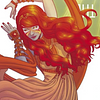Take a photo of a barcode or cover
I wanted to love this, because I love Samira Ahmed, but it was only okay. I didn’t care for the love triangle and I felt like there were too many times where the author wanted to make sure we understood the moral of the story: to let women tell their own stories. The mystery is interesting and it had great potential, but ended up falling flat for me.
I really enjoyed the topic of this book - forgotten women and writing their stories to make our history richer and more diverse - but I found the main character a little frustrating. She was very imperfect, which is fine, but the love triangle she found herself in took away from her story and her growth as a character. I think part of that was intentionally ironic, but it also kept drawing me out of the main plot itself. She was angry at the boys for doing the same things she was doing, and while I appreciate her holding her ground, it also made it hard for me to care about her when she wasn't growing much.
This novel was lyrical and beautiful and well-researched. I'm not big on art or art history, but I was invested in the journey and the reclamation of Leila and her power over several vastly influential historical figures. I wish her chapters added more to the story than just some dramatic irony.
This novel was lyrical and beautiful and well-researched. I'm not big on art or art history, but I was invested in the journey and the reclamation of Leila and her power over several vastly influential historical figures. I wish her chapters added more to the story than just some dramatic irony.
Incredible themes in this fantastic YA book that I highly recommend!! I am honored to share a hometown with Samira Ahmed. Thank you for sharing your talents with our world and #writingherstory! "This is one thing women can do for one another - amplify the voices of our sisters that were silenced because the world told them their stories didn't matter . . . . [Y]ou deserve to be the protagonist in your own life. Every girl deserves to be." Also, I really want to explore Paris now :)
Mad, Bad & Dangerous to Know is full of twists, romance and art. Here are three reasons I think everyone should read it this summer:
1. Khayyam is a superb protagonist. She jumps off the page with every word. I loved her quick humour, sarcasm and her very relatable insecurities. She cares so much about Leila, and her story, ensuring that the reader can't help but care too. She also brilliantly analyses who gets remembered by history and why. She's a brilliant YA heroine I think teenagers will love.
2. One of my favourite things about Love, Hate & Other Filters were all the technical details about cinematography, that really reflected Maya's love for the subject. In Mad, Bad & Dangerous to Know, Ahmed goes into the same level of immersive detail with art, poetry and literature. I don't know very much about art, so I love coming across artist and their works in literature as it encourages me to discover more about them. This story has had me googling Delacroix, digging out books with Byron poems in and wanting to read Dumas for the first time. I'm also keen to read some of the beautiful Persian poetry features in the novel.
3. The setting is beautiful. Even in the height of Summer abandoned by the Parisians, Paris is a perfect story location - especially for one packed with swoonworthy romance (and very yummy cakes). My family and I had a long conversation afterwards about how much better Orangina tastes in the little glass bottles you can always buy in France, and the descriptions of the patisseries were mouthwatering!
If you like romance, dreamy locations, art or cake, you will love this story!
1. Khayyam is a superb protagonist. She jumps off the page with every word. I loved her quick humour, sarcasm and her very relatable insecurities. She cares so much about Leila, and her story, ensuring that the reader can't help but care too. She also brilliantly analyses who gets remembered by history and why. She's a brilliant YA heroine I think teenagers will love.
2. One of my favourite things about Love, Hate & Other Filters were all the technical details about cinematography, that really reflected Maya's love for the subject. In Mad, Bad & Dangerous to Know, Ahmed goes into the same level of immersive detail with art, poetry and literature. I don't know very much about art, so I love coming across artist and their works in literature as it encourages me to discover more about them. This story has had me googling Delacroix, digging out books with Byron poems in and wanting to read Dumas for the first time. I'm also keen to read some of the beautiful Persian poetry features in the novel.
3. The setting is beautiful. Even in the height of Summer abandoned by the Parisians, Paris is a perfect story location - especially for one packed with swoonworthy romance (and very yummy cakes). My family and I had a long conversation afterwards about how much better Orangina tastes in the little glass bottles you can always buy in France, and the descriptions of the patisseries were mouthwatering!
If you like romance, dreamy locations, art or cake, you will love this story!
Thanks to NetGalley for allowing me to read this prior to publication, and introducing me to a story that reeled me in slowly.
The title stems from a phrase used to describe the poet, Lord Byron. I wasn't sure how this phrase could possibly link to the story, but it eventually became clear.
Our narrator is Khayyam, a seventeen year old American student who is fascinated by Art History but who is smarting from her most recent essay being discredited. While on holiday in Paris with her parents, Khayyam meets Alexandre Dumas (yes, really) - a descendant of the writer. They get talking, and before we know it a strange kind of hunt for missing treasure begins.
Both are convinced that Dumas had links with the painter Delacroix, and think that the link has something to do with a mysterious raven-haired beauty mentioned in works by Dumas and Byron, and featuring in paintings by Delacroix. Alongside this story in the present - which, in itself, would have been intriguing - we have the story of Leila, a young woman in the 1800s who has been the favourite of the Pasha, but who cannot bear him children.
It takes a while for the links between the characters and their stories to become clear. The hunt itself took something of a backseat for me as I was captivated by the attitudes to women and how history has, often, overlooked so many stories simply because of the gender of the person telling the story.
This was definitely a story that appeals on a number of levels. Yes, there are some amazing coincidences in this hunt, but the exploration of identity and the passion coming through for the subject was evident.
The title stems from a phrase used to describe the poet, Lord Byron. I wasn't sure how this phrase could possibly link to the story, but it eventually became clear.
Our narrator is Khayyam, a seventeen year old American student who is fascinated by Art History but who is smarting from her most recent essay being discredited. While on holiday in Paris with her parents, Khayyam meets Alexandre Dumas (yes, really) - a descendant of the writer. They get talking, and before we know it a strange kind of hunt for missing treasure begins.
Both are convinced that Dumas had links with the painter Delacroix, and think that the link has something to do with a mysterious raven-haired beauty mentioned in works by Dumas and Byron, and featuring in paintings by Delacroix. Alongside this story in the present - which, in itself, would have been intriguing - we have the story of Leila, a young woman in the 1800s who has been the favourite of the Pasha, but who cannot bear him children.
It takes a while for the links between the characters and their stories to become clear. The hunt itself took something of a backseat for me as I was captivated by the attitudes to women and how history has, often, overlooked so many stories simply because of the gender of the person telling the story.
This was definitely a story that appeals on a number of levels. Yes, there are some amazing coincidences in this hunt, but the exploration of identity and the passion coming through for the subject was evident.
Absolutely stunning book, I haven’t read anything by Samira before, but I’m definitely a fan now. What a fascinating and enthralling read, I was hooked, I loved the romance elements , but I adored the sense of mystery far more. I fell in love with the characters especially Khayyam, she is just fabulous, so relatable, so ‘real’ , the characters are all well developed and I love the fact they are this way, warts and all. I loved the focus on women and their influence/roles and effects through the story. Just simply one of my favourite reads this year.
Thanks to netgalley and the publisher for a free copy for an honest opinion
Thanks to netgalley and the publisher for a free copy for an honest opinion
adventurous
emotional
mysterious
medium-paced
Plot or Character Driven:
A mix
Strong character development:
Yes
Loveable characters:
Yes
Diverse cast of characters:
Yes
Flaws of characters a main focus:
Complicated
I don't much read YA anymore. I have nothing against it; I just lost the flavor for it. Samira Ahmed is always an exception, and Mad, Bad, and Dangerous to Know was phenomenal. Khayyam is a complex main character set out to uncover the truth of the unknown Leila, the subject of many men throughout history, but without a voice herself. Complex, adventurous... One of the books I wish I had when I was a teen, because I think it would have served me better than a lot of what I did have.
Left the book with a list of poems to discover and rediscover. Always a plus!
Left the book with a list of poems to discover and rediscover. Always a plus!
Who knew you could have historical intrigue and bringing lost treasures to light without the violence and mayhem that often finds its way into other stories of this kind? Can't say I missed that at all. Here instead the dark shadow isn't cast by a murderous foe, but rather by the weight of history itself and the stories that it has silenced over the millennia. This emphasizes how we need to give voice to these underrepresented voices today. As the author says in the afterword - "There is room enough on our shelves, and if you find you've run out of space, construct a new bookcase. Build another library. Dig deep to reveal the wrongs of the past, so we can write this world as it should be. So we can right this world. Period."
adventurous
emotional
mysterious
medium-paced
Actual rating: 3.5 stars, but I'm feeling generous?
Khayyam hopes to spend her summer in Paris far from the troubles, both romantic and academic, she left behind in Chicago. Though happenstance or kismet, the young Muslim French-American is given an opportunity to kill two birds with one stone through the mysterious (and rakish) Alexandre Dumas. A descendant of the very same Dumas whom Khayyam happened to submit an essay about proclaiming to be a part of a centuries-old art mystery only to have a judge cruelly tell her she was wrong. Will this mystery boy help prove her theories to be true? And will this same boy be the one to help Khayyam forget about Zaid, the maybe-boyfriend she left in Chicago who happens to be ghosting her?
Two centuries earlier, Lelia, a young woman trapped in the gilded cage of Pasha's harem must use her wits to escape with her true love and the watery grave that is fated for her if her plans are unfolded. The lives of these two women unfold together in this summer read.
So now my thoughts on the book. Right off the bat, I loved the imagery Ahmed created, the detail and atmosphere she imbued in the book made Paris come alive in this book. The art mystery was also a component I enjoyed, although the coincidences throughout the plot were a bit overly unbelievable for my tastes. The historical mentions and intrigue Ahmed injected into this story were some of my favorite parts of the book, but I wish there was more of a balance with Lelia and Khayyam's narratives. I adored Lelia and I understand the creative choice made in limiting her part but still, she was my favorite character.
Now onto what I disliked; the love interests. I could not stand either of the two contenders for Khayyam's affections and honestly neither of deserved her. And because romance was such a key part of the narrative, I didn't enjoy the adventure with Khayyam as much I would have hoped.
Khayyam hopes to spend her summer in Paris far from the troubles, both romantic and academic, she left behind in Chicago. Though happenstance or kismet, the young Muslim French-American is given an opportunity to kill two birds with one stone through the mysterious (and rakish) Alexandre Dumas. A descendant of the very same Dumas whom Khayyam happened to submit an essay about proclaiming to be a part of a centuries-old art mystery only to have a judge cruelly tell her she was wrong. Will this mystery boy help prove her theories to be true? And will this same boy be the one to help Khayyam forget about Zaid, the maybe-boyfriend she left in Chicago who happens to be ghosting her?
Two centuries earlier, Lelia, a young woman trapped in the gilded cage of Pasha's harem must use her wits to escape with her true love and the watery grave that is fated for her if her plans are unfolded. The lives of these two women unfold together in this summer read.
So now my thoughts on the book. Right off the bat, I loved the imagery Ahmed created, the detail and atmosphere she imbued in the book made Paris come alive in this book. The art mystery was also a component I enjoyed, although the coincidences throughout the plot were a bit overly unbelievable for my tastes. The historical mentions and intrigue Ahmed injected into this story were some of my favorite parts of the book, but I wish there was more of a balance with Lelia and Khayyam's narratives. I adored Lelia and I understand the creative choice made in limiting her part but still, she was my favorite character.
Now onto what I disliked; the love interests. I could not stand either of the two contenders for Khayyam's affections and honestly neither of deserved her.






